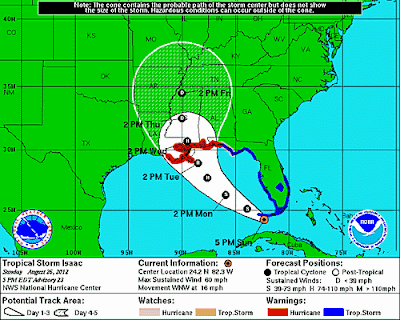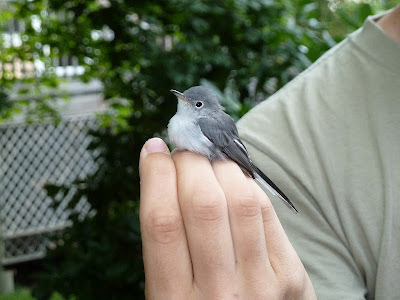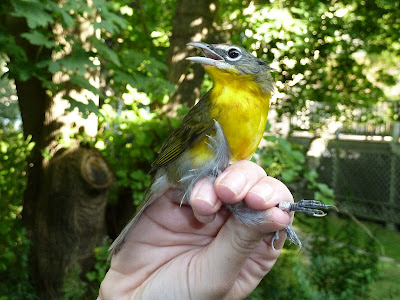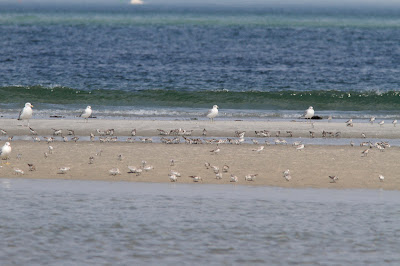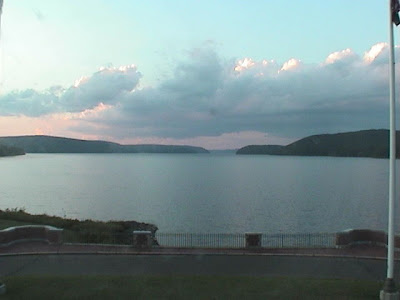 |
| What a difference a year makes, Winsor Dam at dusk, Aug 28, 2012 |
It has been one year since the arrival of Hurricane/Tropical
Storm Irene in western Massachusetts and delivered some incredible birds to the
area. I have written about that day extensively
before but find it worth mentioning again on the one year anniversary. Besides the tropical/pelagic species brought
in from the storm there were a variety of shorebirds. The list for the day is quite amazing when
you look back. Here is the eBird list
submitted by Marshall Iliff for the time that he, Scott Surner and I were at
Winsor Dam at Quabbin Park. I think it
does a great job of summing up the day.
 |
| Sooty Tern, Winsor Dam at Quabbin Park, Aug 28, 2011 |
Quabbin Reservoir--Park
HQ., Hampshire, US-MA
Aug 28, 2011 9:00 AM - 8:00 PM
Protocol: Stationary
Comments: This count is for the full day totals by Marshall Iliff, Scott
Surber, and Larry Therrien, joined by others in afternoon. I kept detailed
hourly totals, so this count is a duplicate of the other 11 checklists. With
Tropical Storm Irene hitting Manhattan at 8:00-9:00 am, and its arrival in
western Massachusetts scheduled for 15:30, I arrived here at 9:00 with the
intention of staying all day and trying for hurricane birds, not least of them
my state Sooty Tern. All week the 'eye' had been forecast to pass over Quabbin
or slightly west, so this seemed like the perfect spot being a large
north-south water body near to or just east of the eye of the storm. Scott
Surner arrived two hours earlier than I and stayed all day; Larry Therrien
joined intermittently, including the whole afternoon. Dozens more joined from
15:00 to 18:00, and were witness to the highlights of this phenomenal day.
Canada Goose 90
Mallard 75
Common Loon 3 adults; one pair seen in display flight
White-tailed Tropicbird 1 ***mega; stunning, full-tailed adult spotted by Larry
Therrien at 16:34 and called out as 'I got something REALLY interesting'! Larry
had not acted this way all day, so I snapped to attention immediately and
followed his directions, expecting a Sooty Tern. When I got on his bird in my
scope, it was flying directly away over the 'gap' (the view to the northern
part of the reservoir) and was flying with fast, shorebird-like wing beats. I
did not instantly realize what I was looking at, and seeing the flight style
and odd black stripe down the back very quickly considered and eliminated
American Avocet and then Pied Avocet. The bird banked slightly about a second
later and I started screaming ADULT WHITE-TAILED TRPICBIRD!, which I am sure is
what Larry knew it was all along! Pandemonium ensured as the bird banked left
and flew towards the island, revealing the long tail streamer flowing wave-like
in the wind. On the water (probably 0.75 to 1 mile distant or so) it sat very
squat, not riding high like gulls, and it propped its rear end up. Occasionally
the long, slim, tail streamers could be seen while sitting, It spent almost all
its time facing right towards us, into the wind, but at one point it turned
sideways and a white bird with a bold black carpal bar could be seen. No one
was quick enough to take photos in flight and when sitting on the water it was
hard enough to keep in the scopes, let alone to photograph. It sat on the water
for over an hour, drifting slowly away from us, until lost from view at about
17:40. Amazingly, one of 10 live White-tailed Tropicbirds seen, with 2 in Delaware,
three in a single Cape May, NJ, seawatch, at least two live (and two dead) in
New York, and one or two at Onota Lake, Pittsfield, MA. Are more are yet to
come? Tom Johnson and other researchers offshore this summer noted elevated
numbers of White-tailed Tropicbirds, which may be a factor in this unprecedented
storm for tropicbirds. DESCRIPTION: Bonaparte's Gull sized bird with gleaming
white plumage and fast, hurried flap. It was flapping constantly and seemed to
require much effort to stay airborne, flying much like a Willet (I once heard a
pelagic Willet called out as a tropicbird) or avocet. The wings were slender
and narrow, and came to blunt points. The tail was long, as long as the body
perhaps, and very slender, flowing with every flap. The upperparts had a bold
black carpal bar and bold black outer primaries (outer wedge, involving several
outer primaries). The back was pure white. I could not see the details of the
head, but there was certainly a mask. I could not see the bill color. The bird flew
left and then wheeled into a glide and flapped as it landed on the water.
Double-crested Cormorant 3
Turkey Vulture 3
Osprey 1
Cooper's Hawk 1 flying across lake; spotted by Dave Donsker
Bald Eagle 2 one ad, one TY
Red-tailed Hawk 1 my first of the day; soaring at dusk to east
Black-bellied Plover 7 *rare; one flying with Hudsonian Godwit flock at about
13:30 and at 18:00-19:00 flock of six flying with two American Golden-Plovers;
in flight, blackish underparts and white rumps and tails easily seen, as well
as larger size relative to the Golden-Plovers
Whimbrel 1 **rare; heard clearly 4x giving 'slightly descending
'kek-kek-kek-kek'. I must admit, I first thought it might be a flicker (an ID
problem I have never had before), but after another two calls it became clear
that it was a Whimbrel and I called it out to the others. We heard it give one
more call then, and after that it must have circled because a minute later we
heard the call again, loud, right overhead. Never seen.
Hudsonian Godwit 12 **rare; about 10:30; I initially counted 11 in the field
but photos clearly show 12
Ruddy Turnstone 4 *rare; flock spotted flying south towards us into wind (and
ultimately over the dam and off to the south) by Mike Resch, who commented on
their dark chests and instantly agreed when I suggested turnstone (before
seeing the birds); flock flew past and seen well in flight. Bold pattern of
white and black on wings with white oval up central lower back and dark smudges
on chest.
Baird's Sandpiper 1 *rare; flying with Ruddy Turnstones and only slightly
smaller and without the chety appearance of Pectoral. Not seen well, but the
size in comparison to turnstone, lack of a bold wingstripe or white rump, and
long-winged appearance all combine to eliminate all species except Baird's,
Buff-breasted, and Pectoral, and I was ocnfident that the shape was not that of
Pectoral. The bill and head were seen well enough to eliminate Buff-breasted
peep sp. 1 small peep, probably Least
large shorebird sp. 20 one tight flock of about 20 shorebirds at 13:30 was
spotted late and mostly got past us before we could Id then; some observers
that saw them best thought Black-bellied Plover, but I felt I saw then well and
saw long trailing legs
Bonaparte's Gull 5 at about 17:10; four distant birds and one much closer
juvenile that landed on water and which I carefully checked for other gull
species
Ring-billed Gull 58 almost all apparently adults
Herring Gull 24 one juvenile, one second-summer, the rest adults
Great Black-backed Gull 1 near adult; 15:00 hour; flew right over dam
Sooty Tern 1 ***mega; arrived at about 16:42; some photos by me may be identifiable
and others (including Scott Surner) were shooting too; fully expected in this
Tropical Storm, and by this time we had heard about Sooty Terns all around us:
Boston, Long Island Sound, Manhattan, Pennsylvania, Maryland, etc. This bird
flew by close (0.5 mi away or so), and generated some chatter as I screamed
ADULT SOOTY TERN! A few people were struggling to get on it, but ultimately all
present (10+ people) had prolonged views as this bird worked its way to the
east side of the dam, fed in the small cove for 5-10 minutes, and then circled
high and flew out over the dam and away (into the wind) to the south.
DESCRIPTION: Moderately large tern, larger than a Common Tern with a
broad-winged appearance but sharply pointed wingtips. It soared several times
for 10-20 seconds and when feeding would swoop down to the water and pick
things from the surface much like a Black Tern might. No molting flight feathers
or aps in the plumage, so otherwise very crisp looking. Underparts pure white. Underwings white with
extensively dark undersides to primaries and secondaries, giving distinct
two-toned appearance (like Swainson's Hawk). White underparts sharply demarcated
from dark upperparts. Upperparts blackish with a faint hint of brownish on the
central back indicating wear. Dark cap and nape connected to back without any
sign of a collar, eliminating Bridled Tern. No contrast between black cap and
blackish back. White forehead large and prominent in from of eyes and suqared
off at rear, not coming to a point over the eye as on Bridled Tern. Tail, when
flared and seen from above, had only a single narrow white rectrix, also
eliminating Bridled Tern which has 2-3. Tail came to a moderate fork, with a
rounded central notch. State bird for me!
Black Tern 3 *rare; 16:10 or so; Mike Resch spotted these distantly; I
concurred with his ID: smallish terns that appeared pale gray overall at a
distance without the white gleam of Sterna terns or contrast of a tropical
tern. All even above (no white tail). I only saw the flying and did not see any
foraging.
Common Tern 2 adults at 13:45 and 9:58
Sterna sp. 2 very distant, presumed Common Tern
Parasitic Jaeger 1 **rare; continuing bird from 13:00-14:00 period; adult or
near adult intermediate morph; clearly not a Pomarine Jaeger, this bird was
dark smoky gray on the head and chest, with a contrasting dark cap. Although I
could not see a pale forehead, this plumage is probably only shown by
Parasitic, since Pomarines are so dark as to have little contrast and have a
more jagged cap margin and more uneven (less smooth) breastband etc. When in
flight the upperwings looked very dark and the tail seemed to have some short,
ragged points as though a non-adult. Some white at base of tail. In flight I
felt size and structure was consistent with arasitic as well, and while I
considered Long-tailed more likely here on this date, I saw nothing to indicate
that species and felt the size was clearly that of Parasitic.
jaeger sp. 1 extremely distant darkish birds that were seemingly the same size.
One showed dark plumage, a paler belly, and a bit of an underwing flash. I did
not know if these were the same or different from the bird seen earlier, but I
assume one of them was the same individual. The distance was extreme and we
were unable to stay on them when flying against dark pines in the background.
Common Nighthawk 8
Chimney Swift 5
Belted Kingfisher 1
Northern Flicker (Yellow-shafted) 1
Blue Jay 2
American Crow 8
Common Raven 2
Tree Swallow 31
Bank Swallow 4
Barn Swallow 24
Cliff Swallow 2
swallow sp. 10
Tufted Titmouse 1
Cedar Waxwing 1
Chipping Sparrow 2
Northern Cardinal 1
Bobolink 4 flight calls heard
American Goldfinch 1
I managed to add
two life birds, four state birds and seven birds to my Hampshire county
list. In addition to the birds the
day of the storm a few days later (September 1st) I also sighted a
large swift species (moving with nighthawks) that very well may have been a Black
Swift.
Here is a link from the day after the storm:
As well as a link regarding the large swift species seen
after the storm:
 |
| Hurricane Isaac projected path as of the evening of Aug 28, 2012 |
On the date of the one year anniversary of Irene a hurricane
looks to be on track to impact the gulf coast over the next few days. Hurricane Isaac is expected to strengthen
before landfall as a category 1 storm.
Although there is likely to be no impact at all from the latest storm
here I have included a link from eBird regarding the possible species that
could be displaced by the storm along the gulf coast:












